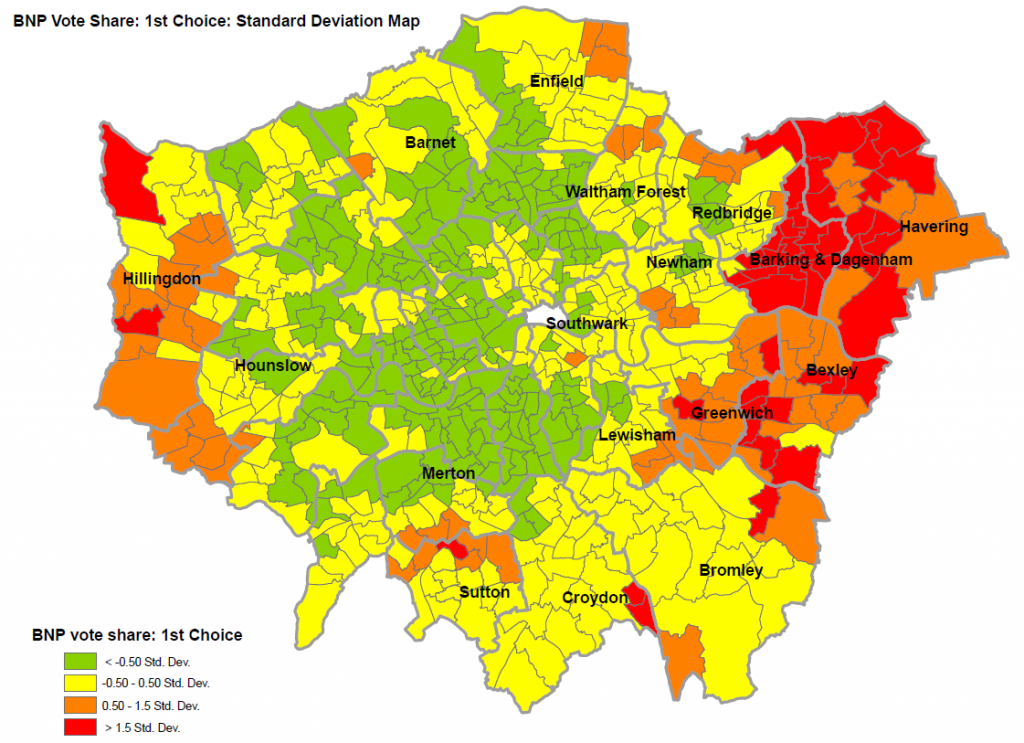 New research by Eric Kaufmann finds that local diversity does lead to more tolerant white attitudes and this is not the result of ‘white flight’. The results suggest that, as more locales become diverse, there will be more interethnic contact and more positive white attitudes to outgroups.
New research by Eric Kaufmann finds that local diversity does lead to more tolerant white attitudes and this is not the result of ‘white flight’. The results suggest that, as more locales become diverse, there will be more interethnic contact and more positive white attitudes to outgroups.
Does living in a diverse area make whites more tolerant of immigration and minorities, or does it cause them to feel threatened and insecure? If whites in diverse places are more tolerant is this because the intolerant whites have left? These questions have important implications in an age of migration. Whether western societies veer to the populist right or towards cosmopolitanism hangs in large part on the answers. This discussion also bears on whether ethnic groups can rub along in divided societies such as Northern Ireland and Syria, or in segregated spots like Chicago and Cape Town.
Gareth Harris and I grapple with these issues in our recently published open access article in Comparative Political Studies. In England and Wales, we find that White British people in wards with more minorities and immigrants are more open to immigration. In wards that are almost entirely white, 90 per cent of White British people want immigration to be reduced; but where visible minorities make up half or more of the population, this drops to about 70 per cent. Half the effect arises because whites in diverse wards tend to be young single urban renters, all relatively tolerant segments. The other half of the explanation, however, seems to involve ‘contact’: mixing with minorities or becoming accustomed to their presence.
We looked at the existing literature and found 24 studies looking at attitudes in units with less than 10,000 people, such as British wards or American census tracts. In these studies, three quarters discovered positive contact effects in which whites living with larger shares of minorities and immigrants displayed more positive attitudes toward outgroups than whites in whiter areas.
Yet there is another, less sunny, side to the story. When we looked at larger geographies above 100,000 population, such as the English Local Authority (LA) or American county, the relationship reversed itself. Of 44 papers we sampled, 84 per cent found a threat effect in which whites living in more diverse places expressed more hostile attitudes to minorities and immigrants.
We confirmed this pattern for immigration opinion in England and Wales using the 2009-2011 Citizenship Surveys. Controlling for numerous properties of individuals, such as education, and of areas, such as deprivation score, white British people in diverse wards (population averaging 7,500) are ten points more accepting of immigration than those in the whitest wards. By contrast, whites in diverse Local Authorities (population around 100,000) are around five points more likely than whites in homogenous LAs to call for restriction.
Moreover, whites living in homogeneous wards nested within diverse LAs express the greatest opposition to current levels of immigration. This echoes what Rydgren and Ruth, in relation to Sweden, dub the ‘halo effect’, whereby anti-immigration party support is strongest in white working-class areas adjacent to diversity. The same pattern shows up in support for the far right in Britain. In the 1970s, East London was a hotbed of National Front activity. By the 2008, East London had become diverse and, as figure 1 shows, the red ‘halo’ of far right support shifted further out.
Figure 1: BNP vote share in 2008 Greater London Authority election
Source: Kaufmann, E. and G. Harris, Changing Places: mapping the white British response to ethnic change (London: Demos, 2014), p. 73
One explanation for the above pattern comes from contact theory: whites who live in diverse Local Authorities or counties lack opportunities to mix with minorities but are close enough to be worried. A policy solution would be to encourage more opportunities for positive inter-group contacts, such as educational, religious or sporting exchanges. A useful analogy is with attitudes to nuclear power plants. Those who live far enough away not to worry, or close enough to understand the actual risks, are less fearful than those in the middle.
But contact theory is not the only explanation for the bifurcated pattern we see. ‘White flight’, the self-selection of white British people who dislike diversity out of multicultural wards, could account for white tolerance in diverse areas and relative intolerance in adjacent districts. This question has not been properly addressed because most previous research has run into data limitations. Longitudinal surveys – those which sample the same people every year – are needed to examine movers. In Europe or the US these do not ask subjective questions so it is impossible to track the opinions of movers. Work with the US Panel Study of Income Dynamics, for example, tells us that whites move to whiter areas than minorities. There is, however, no way of discerning whether anti-immigration whites are overrepresented among those moving to whiter areas.
Luckily, the British Household Panel Survey (BHPS), now Understanding Society (UKHLS), allows us to explore the political leanings of thousands of individuals over two decades. The surveys don’t directly ask about immigration, but we know from other sources such as the British Social Attitudes Survey and British Election Study that certain kinds of voters are relatively pro-immigration while others are very much against. For instance, university-educated left-wing voters (Green, Labour, Lib Dem) tend to be pro-immigration. Conservative voters without degrees, or supporters of populist right parties such as UKIP or the BNP, tend to favour lower levels. We augment the longitudinal work with a specially commissioned YouGov survey which asks people about immigration, party support and whether they moved toward or away from diversity during the past decade.
The results are striking. Essentially, while white British people select whiter areas to move to than minorities, whites who favour and oppose immigration move to similar places. In figure 2, we see that, controlling for a wide range of individual and ward characteristics, such as education or deprivation, whites who originate in diverse wards tend to move to much whiter ones. Yet there is barely a paper clip’s difference between whites who vote for anti-immigration parties (mainly BNP and UKIP) and other whites.
Figure 2: Predicted decrease in minorities as the result of a move (white British only)
Source: Understanding Society, waves 1-3 (2009-12)
Among White British respondents in the BHPS, there is a significant difference between university-educated left-wing (i.e. pro-immigration) voters and others, but the difference is small – only two percentage points. And this only concerns white ‘avoidance’, that is, selective inflow. On the other hand, there is no difference between pro-immigration whites and anti-immigration whites in their propensity to leave a diverse area, i.e. ‘white flight’. If the population of a ward is like water in a tub, we could say that in diverse areas, the water is relatively liberal on immigration. The water entering the tub is 2 points more liberal than average while the water exiting reflects the national average. Even if the entire content of the tub changed completely to match the inflow, the most that self-selection can explain is 2 of the 10-point difference in immigration attitudes between the least and most diverse wards in England and Wales. This almost certainly overstates the effect. The ONS Longitudinal Study shows that there is a significant share of long-term white residents in diverse British wards. We know from our YouGov survey that these ‘stayers’ are more likely even than whites who leave to favour lower levels of immigration.
The bottom line: local diversity does lead to more tolerant white attitudes and this is not the result of white flight. As more locales become diverse, this should lead to interethnic contact and more positive white attitudes to outgroups. Yet at the same time, the ‘halo’ of threat will push out to new areas, awakening threat perceptions. Since more whites live in diverse LAs than in diverse wards, it is difficult to know where the balance will lie. This means policies such as refugee dispersal which reduce minority segregation may not produce more positive white attitudes to immigration. Indeed as we note elsewhere, rapid changes often produce the opposite effect, so policies designed to reduce segregation are better justified on other grounds.
Note: This article gives the views of the author, and not the position of the British Politics and Policy blog, nor of the London School of Economics. Please read our comments policy before posting.
 Eric Kaufmann is Professor of Politics at Birkbeck College, University of London. His latest publication is a Demos report, freely available, entitled Changing Places: the White British response to ethnic change.
Eric Kaufmann is Professor of Politics at Birkbeck College, University of London. His latest publication is a Demos report, freely available, entitled Changing Places: the White British response to ethnic change.
















